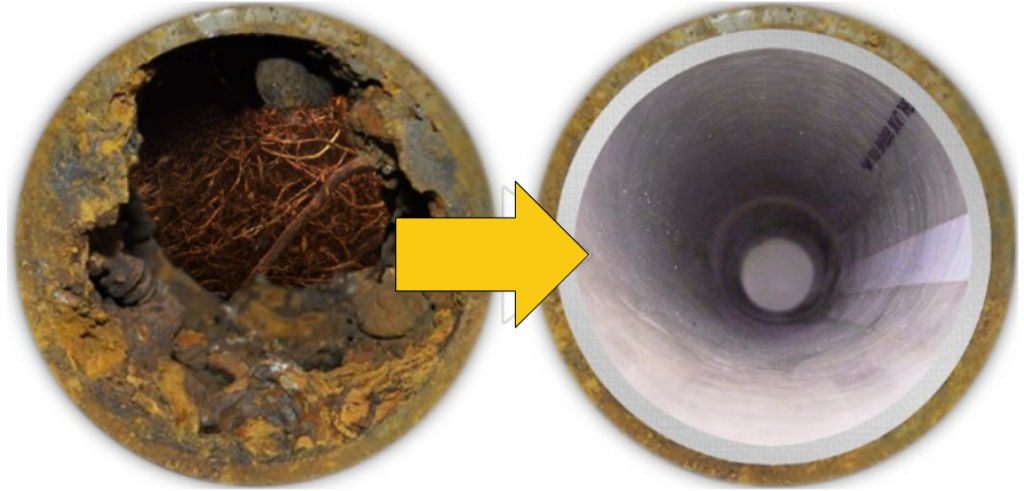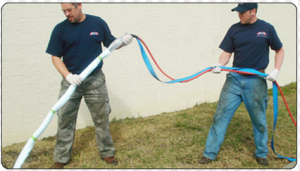How To Fix Backed-Up Cast Iron Sewer Lines With Trenchless Pipe Lining

Trenchless Pipe Lining Of Cast Iron Pipes Explained
This Is How Trenchless Epoxy Pipe Lining Fixes Underground Drains Without Excavation
Trenchless sewer epoxy pipe lining is a popular method to fix backed up cast iron sewer drains. Here are the steps to fix backed up cast iron sewer drains using trenchless sewer epoxy pipe lining:
Inspect the sewer line: First, inspect the cast iron sewer line to determine the location and extent of the damage. This can be done using a video camera inspection.
Clean the sewer line: The sewer line needs to be cleaned thoroughly before applying the epoxy lining. A high-pressure water jet or mechanical cleaning can be used for this purpose.
Measure the pipe: Measure the diameter and length of the sewer pipe to determine the amount of epoxy lining needed.
Mix the epoxy: Mix the two-part epoxy resin according to the manufacturer’s instructions.
Apply the epoxy lining: Use a bladder or inversion method to apply the epoxy lining. In the bladder method, a bladder is inserted into the sewer line and inflated, and the epoxy is applied to the inside of the bladder. In the inversion method, the epoxy is applied to a liner and then inverted into the sewer line. The liner is then expanded to create a tight fit.
Cure the epoxy lining: The epoxy lining needs to cure for several hours or days, depending on the manufacturer’s instructions. During the curing process, the epoxy hardens to create a seamless and durable new pipe within the existing cast iron sewer line.
Re-inspect the sewer line: Once the epoxy lining has cured, inspect the sewer line again to ensure that the repair has been successful.
Trenchless sewer epoxy pipe lining is a relatively quick and non-invasive method to fix backed up cast iron sewer drains. It eliminates the need for digging and disruption to landscaping or hardscaping.
There Are Two Popular Types Of Trenchless Pipe Lining!
Our technology has been around since 1997. Most people don’t know about it, but it is called cured in place pipe lining (older technology), and epoxy pipe lining (newer and better). It simply installs inside the old pipe. It doesn’t matter if there are holes and cracks; it fills those in.
Both have a minimum engineered life of 50 years. Our warranty is 50 years to match the engineered life. When we’re done, we make a video recording of all the light pipes. We upload them online and send you one email with your 50-year transferable warranty, which means it can go to somebody else who buys the home in the future. You also receive the videos in that email, and you’ll receive a payment for the invoice. It takes about four days to do. That’s it.

What Are The Steps In Trenchless Pipe Lining?
Trenchless epoxy pipe lining is a process used to rehabilitate existing cast iron pipes without the need for traditional excavation methods. Here’s how it works:
Inspection: The first step in the process is to inspect the pipeline to determine the extent of the damage and identify any blockages or obstructions that may need to be cleared.
Cleaning: Next, the pipeline is thoroughly cleaned using high-pressure water jets or other specialized equipment to remove any debris or buildup.
Lining Preparation: After cleaning, the pipe is inspected again to ensure that it is clean and free of obstructions. Then, the epoxy resin liner is prepared according to the manufacturer’s instructions.
Lining Installation: The epoxy liner is inserted into the pipe and positioned using a specialized inversion system. The liner is then inflated and cured using hot water, steam, or UV light.
Inspection and Testing: Once the liner has cured, the pipe is inspected again to ensure that the liner is properly installed and that there are no leaks or other defects.
Restoration: The final step is to restore the pipeline to its original condition. This may include repairing any connections or fittings, as well as restoring any landscaping or pavement that was disturbed during the installation process.
Overall, trenchless epoxy pipe lining is a cost-effective and efficient way to rehabilitate pipelines without the need for excavation, making it an ideal solution for a wide range of applications.

How Much Does Epoxy Pipe Lining Cost?
So how much does it cost to reline pipes for a 2,000 square foot house instead of replacing the pipes?
It’s between $17,000 and $20,000. If you were to excavate the floors to physically replace the pipes it would take about two months and you would have to pay between $50,000 and $70,000.
It only takes 3 days to line the pipes, and we email you copies of the final videos of the re-lined pipes with your 50-year transferable warranty and your paid in full invoice. You get that all in one email. You can never lose any of that, and you can just forward that email to somebody who buys it properly in the future.
